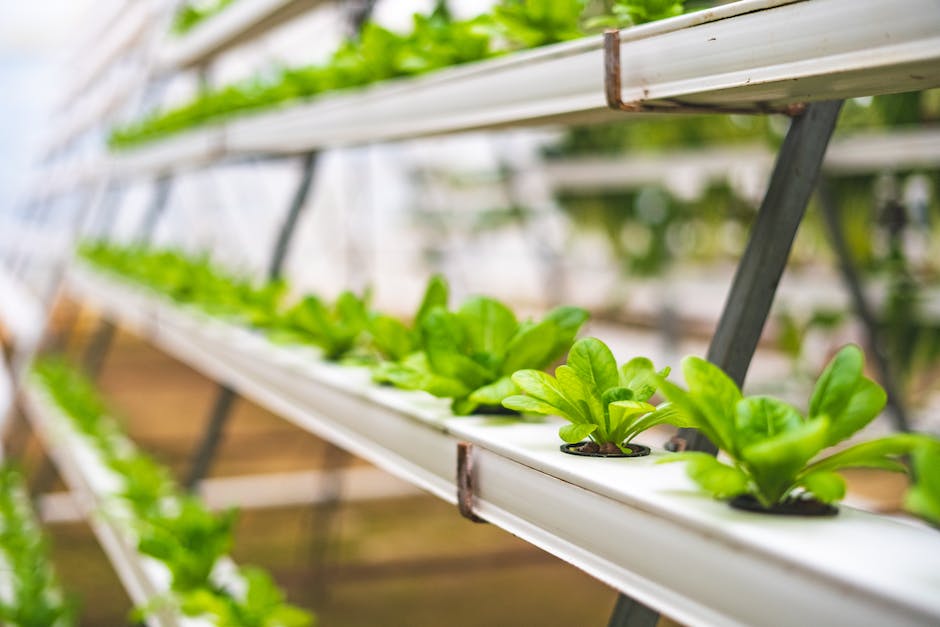Who Invented Hydroponics
Hydroponics, the innovative method of growing plants without soil, has gained significant popularity in recent years. But have you ever wondered who first invented this highly efficient technique? In this blog post, we will delve into the fascinating history of hydroponics and explore the brilliant mind behind its creation. From ancient civilizations to modern advancements, the journey of hydroponics is filled with ingenuity and scientific breakthroughs. So, let’s embark on this journey together and discover the remarkable individual responsible for revolutionizing modern agriculture with hydroponics.
Explanation of hydroponics as a soilless method of growing plants
Hydroponics, a soilless method of growing plants, has gained significant attention in recent years due to its efficiency and sustainable nature. In this innovative system, plants are cultivated in nutrient-rich water solutions, eliminating the need for traditional soil-based cultivation. This unconventional approach to agriculture has revolutionized the way we grow plants, offering numerous advantages over conventional farming practices.
In hydroponics, plants are grown in specially designed containers or systems that allow their roots to come into direct contact with the nutrient-rich water solution. This solution is carefully balanced to meet the specific nutritional requirements of each plant species. By supplying the necessary nutrients directly to the roots, plants can absorb them more efficiently, leading to faster growth rates and increased yields.
One of the primary benefits of hydroponics is its water efficiency. As the plant roots are submerged in a closed-loop system, there is minimal water loss through evaporation and runoff. The water used in the hydroponic system can be continually recycled, reducing water consumption by up to 90% compared to traditional soil-based farming. This crucial advantage makes hydroponics an environmentally friendly alternative in regions facing water scarcity or drought conditions.
Additionally, hydroponics allows for precise control over various environmental factors such as temperature, humidity, and pH levels. These factors can be adjusted to create optimal growing conditions for each plant species, resulting in healthier plants and higher crop yields. By eliminating the reliance on natural soil conditions, hydroponics also minimizes the risk of soil-borne diseases and pests, reducing the need for harmful pesticides and insecticides.
The versatility of hydroponics is another significant advantage. This method can be utilized both indoors and outdoors, making it a viable option for urban areas with limited space. Vertical farming systems, in particular, have gained popularity in urban environments, allowing for the cultivation of plants in vertically stacked layers. With hydroponics, urban dwellers can participate in sustainable food production, contributing to local food security and reducing their environmental footprint.
Despite its undeniable benefits, hydroponics does require careful monitoring and management. The nutrient concentrations, water pH, and temperature levels must be regularly monitored and adjusted to ensure optimal plant growth. Additionally, a stable power supply is necessary for maintaining the functioning of essential components such as pumps, lights, and temperature control systems.
In conclusion, hydroponics offers a revolutionary solution to modern agriculture, addressing the challenges of water scarcity, limited space, and environmental impact. By eliminating the dependence on soil and implementing efficient water and nutrient management, hydroponics presents an opportunity for sustainable plant cultivation on a large scale. As technology and knowledge continue to advance, the future of hydroponics holds exciting breakthroughs and widespread adoption, positioning it as a key player in the agriculture industry.
Importance of understanding the origins of hydroponics

Understanding the origins of hydroponics is essential for anyone interested in the field of modern agricultural practices. By delving into the history of this innovative technology, we gain valuable insights into its importance and potential for future advancements.
First and foremost, knowing who invented hydroponics allows us to appreciate the dedication and effort that pioneers put into developing this methodology. The concept of soilless agriculture stretches back thousands of years, with early civilizations experimenting with various techniques to grow plants in water or alternative media. However, it was not until the 19th century that modern hydroponics began to take shape.
One of the significant contributors to the development of hydroponics was Julius von Sachs, a German botanist and the first person to grow plants in a nutrient solution. His experiments laid the foundation for further advancements in hydroponics and helped establish the scientific principles that underpin this practice.
Another crucial figure in hydroponic history is Dr. William Frederick Gericke. In the 1930s, Gericke, a professor of agricultural chemistry at the University of California, Berkeley, coined the term “hydroponics” and further popularized this method in the United States. Gericke’s research and successful application of hydroponics in commercial agriculture showcased the potential for increased crop yields and improved food production, sparking widespread interest in this innovative approach.
Understanding the origins of hydroponics also emphasizes the importance of resource efficiency and sustainability. As the global population continues to grow, ensuring food security becomes a top priority. Hydroponics offers a promising solution by maximizing crop yields while minimizing the use of land, water, and fertilizers. By tracing the roots of this technology, we gain a deeper appreciation for its role in addressing the challenges faced by modern agriculture.
Moreover, studying the historical context and development of hydroponics helps us identify areas for future improvements and innovation. By learning from the past, we can build upon existing techniques and experiment with novel approaches, pushing the boundaries of what is possible in hydroponic farming. This knowledge allows businesses and entrepreneurs in the field to stay ahead of the curve, delivering new and improved solutions to meet the ever-growing demand for sustainable and efficient agriculture.
In conclusion, understanding the origins of hydroponics provides us with a comprehensive perspective on the importance of this technology. By recognizing the contributions of early pioneers and their groundbreaking research, we appreciate the potential of hydroponics for revolutionizing modern agricultural practices. Additionally, this knowledge enables us to address food security concerns, promote resource efficiency, and explore new possibilities for further advancements in this field.
Prehistoric origins of hydroponics

Hydroponics, a revolutionary method of growing plants without soil, may seem like a modern invention. However, its origins can be traced back to prehistoric times. Archaeological evidence suggests that ancient civilizations, such as the Babylonians and the Egyptians, were already utilizing hydroponic techniques thousands of years ago.
In ancient Babylonia, the Hanging Gardens, one of the Seven Wonders of the Ancient World, is believed to have employed hydroponic principles. These stunning gardens were located in the city of Babylon and were built by King Nebuchadnezzar II to please his wife, who yearned for the beautiful vegetation of her homeland. Water was ingeniously pumped from the Euphrates River into elevated terraces where plants thrived, showcasing the mastery of hydroponic cultivation.
Moving forward to ancient Egypt, the Nile River played a significant role in the civilization’s agricultural practices. Each year, the river would flood and deposit nutrient-rich sediments onto the surrounding land, providing an ideal condition for crop growth. Egyptians began experimenting with ways to control the water supply and regulate plant growth in various environments. By suspending plants in water and using natural fertilizers, they developed rudimentary hydroponic systems that allowed agriculture to flourish even in arid regions.
These early attempts at hydroponics paved the way for further advancements in plant cultivation techniques. Not only did they demonstrate the potential for growing crops without relying on soil, but they also showcased the benefits of precise nutrient delivery, efficient water usage, and the ability to control environmental conditions.
While the true inventors of hydroponics may forever remain unknown, the prehistoric beginnings of this innovative agricultural practice reflect humanity‘s constant quest for efficient and sustainable solutions. As time progressed, hydroponics evolved and became a significant part of modern agriculture, finding applications in commercial farming, urban gardening, and even space exploration.
As we appreciate the modern marvels of hydroponics, it is essential to acknowledge the trailblazing ancient civilizations whose ingenuity and curiosity set the stage for this revolutionary method of plant cultivation. Their early experiments and successes laid the foundation for the scientific and technological advancements that make hydroponics a vital component of today’s professional and sustainable farming practices.
Mention of early examples of ancient civilizations using basic hydroponic techniques (e.g., Hanging Gardens of Babylon)

The history of hydroponics dates back to ancient civilizations, where early examples of basic hydroponic techniques can be seen. One notable example is the Hanging Gardens of Babylon, which was believed to have been built around 600 BCE by King Nebuchadnezzar II. The Hanging Gardens were known for their breathtaking beauty and impressive engineering, showcasing the advanced understanding of water management and plant cultivation of that time.
Although the exact details of the hydroponic system used in the Hanging Gardens are not fully known, historians suggest that it involved a series of tiered gardens with plants grown in large terracotta pots. These pots would have been lined with a layer of clay to prevent water from seeping through, allowing for controlled irrigation of the plants. Water was likely transported from the nearby Euphrates River using a network of canals and aqueducts.
The Hanging Gardens of Babylon were not the only ancient example of hydroponic gardening. In the ancient Aztec civilization, the technique of growing plants on floating rafts called “chinampas” was widely practiced. These floating gardens were constructed by creating artificial islands from mud and reeds, which were anchored to the bottom of lakes and used for crop cultivation. The chinampas were highly efficient in terms of water usage and allowed for high crop yields.
These early civilizations demonstrated a pioneering understanding of hydroponics, using innovative techniques to grow crops in controlled environments with limited resources. Their advancements in water management and plant cultivation laid the foundation for the modern-day hydroponic systems that are widely used in agriculture and horticulture today.
As we explore the rich history of hydroponics, it is evident that the concept of growing plants without soil has been practiced and refined over centuries. The Hanging Gardens of Babylon and Aztec chinampas serve as inspiring examples of human ingenuity and adaptability, showing that even in ancient times, people recognized the potential of hydroponics for sustainable food production and gardening.
Limited knowledge and documentation in this area

Hydroponics, a modern agricultural technique that involves growing plants without soil, has gained significant popularity in recent years. With its ability to maximize space, conserve water, and control nutrient levels, hydroponics offers a promising solution for sustainable and efficient farming. However, when it comes to tracing the origins of hydroponics, researchers and experts often encounter limited knowledge and documentation in this area.
One of the reasons for this lack of historical records is that hydroponics as a practice is not a recent invention. In fact, the concept of soil-less cultivation can be traced back to ancient civilizations such as the Babylonians and Aztecs who used various forms of hydroponics to grow their crops. However, the knowledge and techniques employed by these early civilizations were not extensively documented, making it difficult to pinpoint specific inventors or pioneers in the field.
In more recent times, the interest in hydroponics began to gain traction during the 19th century. Revolutionary scientists and researchers like Julius von Sachs and William Frederick Gericke made significant contributions to the development of hydroponics as we know it today. Yet, even with their notable advancements, limited documentation exists that explicitly credits these individuals as the sole inventors of hydroponics.
The challenges in identifying the true inventor of hydroponics are further compounded by the fact that the technique has evolved over time through the collective efforts of scientists, researchers, and innovators worldwide. With each new discovery and innovation, the boundaries of hydroponics have expanded, making it even more challenging to pinpoint a single inventor or moment of creation.
While the lack of concrete information about the origins of hydroponics may be frustrating, it also highlights the collaborative nature of scientific progress. The field of hydroponics has developed through a shared pursuit of knowledge, with each advancement building upon the work of those before. Today, a multitude of experts and enthusiasts continue to contribute to this field, constantly pushing the boundaries of hydroponics and finding new, innovative ways to cultivate crops.
In conclusion, the history of hydroponics is both fascinating and elusive. Limited knowledge and documentation hinder our ability to attribute the invention of hydroponics to a specific individual or moment in time. However, this does not diminish the significant impacts and advancements that various scientists and researchers have made in this field. As hydroponics continues to revolutionize modern agriculture, it is essential to recognize and appreciate the collective effort that has led us to where we are today.
Emergence of hydroponics in research and experimentation (18th-19th century)

During the 18th and 19th centuries, there was a significant emergence of hydroponics as a concept in both research and experimentation. This period marked a significant shift towards understanding alternative methods of cultivation and finding more efficient ways to grow plants without relying solely on soil.
One of the key figures during this time was German botanist Julius von Sachs. Through his groundbreaking experiments on plant nutrition and physiology, he laid the foundation for the development of hydroponics. Sachs developed nutrient solutions that allowed him to grow plants in a controlled environment without the use of soil. His research demonstrated that plants could be successfully cultivated by providing them with essential nutrients dissolved in water.
Another significant advancement in the emergence of hydroponics came from the work of British botanist William Frederick Gericke. In the 1920s, Gericke conducted extensive experiments at the University of California, where he successfully grew tomatoes, cucumbers, and other crops using a solution of mineral nutrients rather than soil. His experiments not only proved the feasibility of hydroponic cultivation but also showcased its potential to revolutionize agriculture by maximizing crop yields and conserving resources.
The research and experimentation carried out during the 18th and 19th centuries laid the groundwork for further advancements in hydroponics technology. These discoveries challenged the traditional methods of agriculture and opened up new possibilities for sustainable and efficient plant cultivation. Today, these early pioneers of hydroponics are recognized for their contributions to modern farming practices and the ongoing development of this innovative cultivation method.
The discovery of water-based nutrient solutions by German botanist Julius von Sachs in the late 19th century

During the late 19th century, the field of hydroponics saw a significant breakthrough with the discovery of water-based nutrient solutions by German botanist Julius von Sachs. A pioneer in the scientific study of plant physiology, von Sachs revolutionized the way plants could be cultivated by eliminating the need for soil altogether.
Von Sachs’ experiments focused on understanding the vital role of mineral nutrients in plant growth and development. Through his meticulous research, he found that plants could thrive in a soilless environment if provided with the necessary nutrients dissolved in water. This breakthrough was a major turning point in agricultural practices and opened up new possibilities for food production in areas where fertile soil was scarce.
With his innovative approach, von Sachs revolutionized traditional farming methods by developing a system that allowed plants to grow directly in water, supported by mediums like gravel or sand. This water-based system, known as hydroponics, provided the perfect balance of nutrients required for optimum plant growth.
The significance of von Sachs’ discovery was not limited to its practical applications; it also challenged conventional notions of how plants acquire nutrients. Until then, it was widely believed that plants could only obtain nutrients through their root systems in contact with soil. Von Sachs’ research debunked this assumption, showcasing the potential for cultivating plants using synthetic nutrient solutions.
Von Sachs’ findings paved the way for further advancements in hydroponics, leading to its adoption in commercial greenhouses and research institutions around the world. Today, hydroponics has become a popular and sustainable method of cultivation, offering numerous advantages such as water and resource conservation, increased yields, and the ability to grow crops in urban areas or inhospitable environments.
The work of Julius von Sachs serves as a testament to the power of scientific exploration and innovation in transforming traditional practices. His discovery of water-based nutrient solutions revolutionized the field of hydroponics and continues to shape modern agricultural practices. As we continue to face challenges in feeding a growing global population, von Sachs’ groundbreaking research remains relevant, offering potential solutions for sustainable and efficient food production.
Early experiments on water culture solutions by French botanist Abel Pifre in the mid-19th century

In the mid-19th century, as the Industrial Revolution was underway, many scientists and researchers were exploring innovative methods of cultivating plants. One such visionary was the French botanist Abel Pifre, who conducted early experiments on water culture solutions which eventually laid the foundation for modern hydroponics.
Pifre’s fascination with plants and their growth patterns led him to question the traditional methods of soil-based agriculture. He believed that by directly providing plants with the necessary nutrients dissolved in water, they could potentially grow faster and healthier. With this idea in mind, Pifre embarked on a series of experiments that would forever change the way plants could be nurtured.
Pifre’s experiments primarily involved suspending the roots of plants in nutrient-rich water solutions while supporting them with inert materials like sand or gravel. By doing so, he eliminated the need for soil and allowed the plants to directly absorb the nutrients they required for growth. This approach not only reduced the risk of soil-borne diseases but also provided plants with a more efficient way of obtaining nourishment.
Despite the limited resources available to him in that era, Pifre’s experiments yielded impressive results. He successfully grew various plants, including vegetables and flowers, using his water culture solution method. Pifre’s pioneering work demonstrated the enormous potential of hydroponics and its ability to revolutionize the field of agriculture.
Although Pifre’s experiments and subsequent discoveries were significant, it would take several decades for hydroponics to gain widespread recognition and adoption. However, his early experiments were a crucial stepping stone in the evolution of this thriving agricultural technique.
Today, hydroponics has become an integral part of modern agriculture, offering numerous benefits such as increased crop yields, efficient use of resources, and the ability to cultivate plants in areas with limited arable land. As we marvel at the advancements in hydroponics, let us also remember the role played by Abel Pifre, whose curiosity and visionary approach paved the way for this innovative agricultural method.

